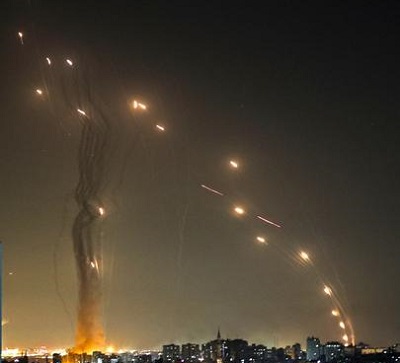 Rakiety odpalane z Gazy. Między 10 a 20 maja terroryściu Hamasu i Islamskiego Dżihadu wystrzelili w kierunku izraelskich miast ponad cztery tysiące rakiet. (Część spadała na mieszkańców Gazy.)
Rakiety odpalane z Gazy. Między 10 a 20 maja terroryściu Hamasu i Islamskiego Dżihadu wystrzelili w kierunku izraelskich miast ponad cztery tysiące rakiet. (Część spadała na mieszkańców Gazy.)
 To Hamas, a nie Izrael, jest winny najnowszego rozlewu krwi
To Hamas, a nie Izrael, jest winny najnowszego rozlewu krwi
Bassem Eid
Tłumaczenie: Małgorzata Koraszewska
Urodziłem się na okupowanym przez Jordanię Starym Mieście Jerozolimy i żyłem w obozie dla uchodźców ONZ-u od 1966 do 1999 roku. Podczas pierwszej intifady pracowałem dla B’Tselem, izraelskiego Ośrodka Praw Człowieka na Okupowanych Terytoriach, a w 1996 roku założyłem mieszczącą się w Jerozolimie grupę Monitorowania Palestyńskich Praw Człowieka. Przy takim życiorysie i moim obecnym miejscu zamieszkania we wschodniej Jerozolimie, moglibyście zakładać, że jestem przeciwny obecnej akcji militarnej Izraela. Nie mogłoby to jednak być dalsze od prawdy. Wina za rozlew krwi w tym miesiącu leży wyłącznie po stronie Hamasu.
Ci, którzy pragną odwrócić uwagę od zbrodni wojennych Hamasu, będą pewnie winą za ten ostatni konflikt obarczali skomplikowany prawny spór w dzielnicy Szejk Dżarrah. To jest jednak prywatna sprawa między Żydami, którzy mają tytuł własności tej nieruchomości od lat 1800., a mieszkańcami czterech domów, którzy odmawiają płacenia czynszu. Tego nie da się przedstawić jako „czystki etnicznej”. To jest spór między właścicielem domu a lokatorami. Powinna to być sprawa dla rejonowego sądu, ale zamiast tego skończyło się odwołaniem do Sądu Najwyższego i dostało na łamy prasy. Hamas szybko zwietrzył okazję.
Prezydent Mahmoud Abbas, przywódca partii Fatah, jest obecnie w najsłabszej od lat pozycji. Właśnie odwołał wybory parlamentarne, ponieważ wiedział, że je przegra. Hamas dostrzegł w Szejk Dżarrah okazję do pokazania Palestyńczykom w Jerozolimie i gdzie indziej, że potrafi “zrobić coś”, czego Fatah nie potrafił. Hamas szerzył kłamstwa i propagandę w mediach społecznościowych, świadomie podżegając do przemocy Palestyńczyków we wschodniej Jerozolimie. Następnie „odpowiedział” na rozruchy przez wściekły ogień rakietowy na Tel Awiw i Jerozolimę, gwarantując militarną reakcję Izraela.
Hamas nie dba o to, gdzie wylądują te rakiety: Izraelskie Siły Obronne informują, że podczas ostatniej rundy walk co najmniej jedna z siedmiu spadła w samej Gazie (w późniejszym artykule Eid pisze, że ma informacje z samej Gazy, iż około jedna czwarta rakiet Hamasu ląduje w Gazie, i że te rakiety spowodowały już ponad 50 palestyńskich ofiar – M.K.), powodując 20 ofiar śmiertelnych. Hamas widzi nierówną liczbę zabitych jako coś pozytywnego, ponieważ pozwala mu to twierdzić, że Izrael jest agresywną stroną w konflikcie, który Hamas zaczął. Ta islamistyczna grupa terrorystyczna jest niebezpieczna dla naszych ludzi: nie możemy nadal być bazą dla ich działania.
Hamas nie walczy o prawa człowieka; popełnia zbrodnie wojenne, by podnieść swój polityczny status. Niedawne wideo pokazało przywódców Hamasu świętujących ostrzał rakietowy podczas przyjęcia w Katarze. Ci ludzie są w bezpiecznym miejscu. Pozostawiają szeregowych żołnierzy, często młodych i zdesperowanych mężczyzn bez żadnych szans na pracę, by prowadzili ataki z budynków mieszkalnych. Niedawno widzieliśmy izraelskie uderzenie w wieżowiec, w którym mieściła się Al-Dżazira, AP i inne media. Według izraelskich źródeł Hamas miał w tym budynku biura wywiadu wojskowego i poprzednio odpalał rakiety z tego właśnie miejsca, używając zagranicznych mediów jako ludzkiej tarczy. Dane izraelskiego wywiadu wystarczyły, by Amerykanie zaakceptowali zasadność tego uderzenia. „Pokazaliśmy im dymiący rewolwer, dowodząc, że Hamas działał w tym budynku” – powiedział jeden z dyplomatów dziennikarzowi „Jerusalem Post”. – „Rozumiem, że uznali wyjaśnienie za zadowalające”.
Nigdy o tym jednak nie usłyszelibyście w zachodnich mediach, bo relacjonowanie z Gazy nie jest uczciwe. Hamas ściśle kontroluje całą prasę i zagraniczne media mają wybór albo przekazywania wiadomości w sposób, w jaki nakazuje im Hamas, albo w ogóle nie otrzymywania prawa wjazdu do Gazy. Niemal wszystkie media wybierają to pierwsze.
Palestyńczycy muszą wybierać między skorumpowanym, nieudolnym Fatahem, a fanatycznym, ludobójczym Hamasem. Oczywiście to jest w zasadzie akademicka kwestia. Nie ma prawdziwego “wyboru” – nie było wyborów od 15 lat. Jest jednak inna, bardziej paląca sprawa niż wpędzający w depresję stan naszego obecnego przywództwa: odmowa uznania rzeczywistości, że Izrael i Żydzi są tutaj na stałe.
Minęły 73 lata od powstania Izraela. Przywódcy Egiptu, Jordanii, Maroka, Bahrajnu, Sudanu i Zjednoczonych Emiratów Arabskich zrozumieli, że Izrael nie jest tymczasową plamą na mapie, ale trwałym elementem Bliskiego Wschodu. Niestety, wielu Arabów, włącznie z większością Palestyńczyków, nadal zaprzecza tej oczywistej prawdzie.
Obsesja na punkcie sprawy izraelsko-palestyńskiej była nieszczęściem dla świata arabskiego: zatrzymała rozwój na pokolenia i drogo kosztowała lud palestyński. Izrael jest tutaj – i nie odejdzie. Świat arabski jest wielki i jest w nim mnóstwo miejsca dla nas wszystkich. Zostaliśmy pobłogosławieni naturalnymi zasobami, które mogły dostarczyć szczodrych możliwości. Zamiast skupiać nasze bogactwo i talent na tworzeniu lepszego życia dla nas, nasi przywódcy spędzili dziesięciolecia na walce z Izraelem. Już dawno była pora dla wszystkich Arabów, by przestali marnować zasoby na próby podbicia maleńkiego kraiku, którego nigdy nie pokonają. Tylko wtedy będziemy mieli pokój i dobrobyt.
Zawartość publikowanych artykułów i materiałów nie reprezentuje poglądów ani opinii Reunion’68,
ani też webmastera Blogu Reunion’68, chyba ze jest to wyraźnie zaznaczone.
Twoje uwagi, linki, własne artykuły lub wiadomości prześlij na adres:
webmaster@reunion68.com




